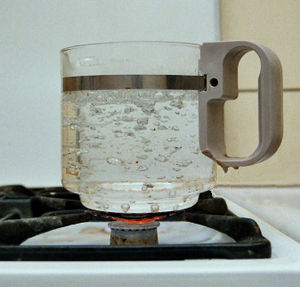Specific heat capacity

Specific heat capacity is the amount of heat needed to raise one gram of a material by one degree celsius (oC).[2] It is expressed in Joules per gram per degree celsius (), and is given by the equation:[3]
where
- is the specific heat,
- is the heat needed,
- is the mass and
- is the change in temperature of the system.
This equation does not apply if a phase change is encountered, because the heat added or removed during a phase change does not change the temperature.[3]
The specific heat for water is , which gives the definition of the calorie, and is relatively high compared to other common substances. As a result, water plays a very important role in temperature regulation.[3]
The third law of thermodynamics shows that as an object approaches absolute zero, its specific heat capacity gets greater and greater, with the consequence that although substances can get very close to this temperature, nothing will ever reach it.[4]
References
- ↑ Wikimedia Commons [Online], Available: http://upload.wikimedia.org/wikipedia/commons/1/18/Kochendes_wasser02.jpg
- ↑ UC Davis Chemwiki, Heat Capacity [Online], Available: http://chemwiki.ucdavis.edu/Physical_Chemistry/Thermodynamics/Calorimetry/Heat_Capacity#Specific_Heat_Capacity
- ↑ 3.0 3.1 3.2 Hyperphysics, Specific Heat [Online], Available: http://hyperphysics.phy-astr.gsu.edu/hbase/thermo/spht.html
- ↑ B. Everett, G. Boyle, S. Peake and J. Ramage, "Heat to motive power," in Energy Systems and Sustainability, 2nd ed., Oxford, UK: Oxford, 2013, ch.6, pp.187

